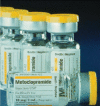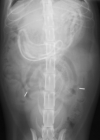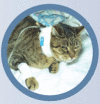Acute vomiting in cats: rational treatment selection
- PMID: 20193913
- PMCID: PMC10829162
- DOI: 10.1016/j.jfms.2010.01.005
Acute vomiting in cats: rational treatment selection
Abstract
Practical relevance: The control of nausea and vomiting in cats is important in order to prevent the development of food aversion, anorexia (with its associated complications of weight loss and dehydration), and hepatic lipidosis.
Clinical challenges: There are several antiemetic drugs that are clinically effective in cats. Making a rational choice from the available options requires knowledge of the likely cause of the vomiting, and the mechanisms of action and side effects of each drug. For example, a drug such as prochlorperazine, which can cause sedation, may be a useful first-line choice in a hospitalized cat that requires mild sedation to be handled, but would be undesirable in a critically ill cat.
Audience: For companion animal and feline practitioners, the vomiting cat is a common presentation.
Evidence base: The guidance provided in this review draws on the findings of clinical trials in humans, experimental studies in cats, some clinical trials in cats, and clinical experience.
Copyright 2010 Elsevier Ltd. All rights reserved.
Figures





Similar articles
-
Antiemetic agents.Oncology (Williston Park). 2007 Jul;21(8 Suppl):48. Oncology (Williston Park). 2007. PMID: 17844897 No abstract available.
-
Dolasetron: a new option for nausea and vomiting.J Am Anim Hosp Assoc. 2000 Nov-Dec;36(6):481-3. doi: 10.5326/15473317-36-6-481. J Am Anim Hosp Assoc. 2000. PMID: 11105883 Review. No abstract available.
-
Antiemetic therapy for nausea and vomiting in the emergency department.J Emerg Med. 2010 Sep;39(3):330-6. doi: 10.1016/j.jemermed.2009.08.060. Epub 2009 Dec 21. J Emerg Med. 2010. PMID: 20022195 Review.
-
A randomized comparison of droperidol, metoclopramide, tropisetron, and ondansetron for the prevention of postoperative nausea and vomiting.Gynecol Obstet Invest. 2011;71(1):59-65. doi: 10.1159/000320747. Epub 2010 Dec 15. Gynecol Obstet Invest. 2011. PMID: 21160196 Clinical Trial.
-
[Prevention and treatment of postoperative nausea and vomiting with 5-HT3-receptor blockers].Anasthesiol Intensivmed Notfallmed Schmerzther. 1996 May;31(4):200-4. doi: 10.1055/s-2007-995902. Anasthesiol Intensivmed Notfallmed Schmerzther. 1996. PMID: 8704077 Review. German.
Cited by
-
ACVIM consensus statement on pancreatitis in cats.J Vet Intern Med. 2021 Mar;35(2):703-723. doi: 10.1111/jvim.16053. Epub 2021 Feb 15. J Vet Intern Med. 2021. PMID: 33587762 Free PMC article.
-
Feline comorbidities: What do we really know about feline triaditis?J Feline Med Surg. 2020 Nov;22(11):1047-1067. doi: 10.1177/1098612X20965831. J Feline Med Surg. 2020. PMID: 33100169 Free PMC article. Review.
-
Evaluation of the Antinociceptive Effect of Maropitant, a Neurokinin-1 Receptor Antagonist, in Cats Undergoing Ovariohysterectomy.Vet Med Int. 2019 Apr 8;2019:9352528. doi: 10.1155/2019/9352528. eCollection 2019. Vet Med Int. 2019. PMID: 31093325 Free PMC article.
-
Feline CKD: Current therapies - what is achievable?J Feline Med Surg. 2013 Sep;15 Suppl 1(1 Suppl):29-44. doi: 10.1177/1098612X13495241. J Feline Med Surg. 2013. PMID: 23999184 Free PMC article. Review.
-
Post-treatment with maropitant reduces oxidative stress, endoplasmic reticulum stress and neuroinflammation on peripheral nerve injury in rats.PLoS One. 2024 Mar 20;19(3):e0287390. doi: 10.1371/journal.pone.0287390. eCollection 2024. PLoS One. 2024. PMID: 38507417 Free PMC article.
References
-
- Hay AM, Man WK. Effect of metoclopramide on guinea pig stomach: Critical dependence on intrinsic stores of acetylcholine. Gastroenterol 1979; 76: 492–96. - PubMed
-
- Durazo FA, Valenzuela JE. Effect of single and repeated doses of metoclopramide on the mechanisms of gastroesophageal reflux. Am J Gastroenterol 1993; 88: 1657–62. - PubMed
-
- Jovanovic-Micic D, Samardzic R, Beleslin DB. The role of alpha-adrenergic mechanisms within the area postrema in dopamine-induced emesis. Eur J Pharmacol 1995; 272: 21–30. - PubMed
-
- Lucot JB, Crampton GH. Xylazine emesis, yohimbine and motion sickness susceptibility in the cat. J Pharmacol Exp Ther 1986; 237: 450–55. - PubMed
Publication types
MeSH terms
Substances
LinkOut - more resources
Full Text Sources
Medical
Miscellaneous

